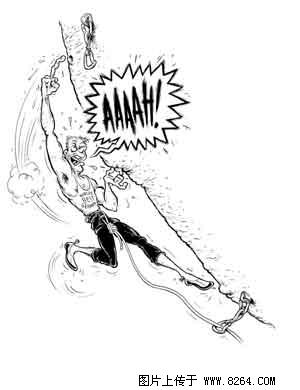Translated: Climbing Tech Tips 195 Author: Andy Beerman compile: Zhang Qing
The older generation of rock climbers often laughed at their lack of skill when they saw small heads jumping on bouldering routes. In the former case, this kind of monkey-like movement may have some meaning in the bouldering, but the "real" climb needs a more "good" style.
But when CHRIS SHARMA and his young partners began to jump back and forth on the hardest route in the United States and walk freely, this misconception was completely overturned. The secret of the younger generation lies not only in the power of the skeleton, but also in the way they use power—using dynamic actions, using momentum momentum to rush to the next fulcrum. Want to add some energy to your climb? Here are some tips.
Let the dynamic concept deep in your mind. If you understand all the fulcrum on the route, consider whether some actions using dynamic or elastic force will improve efficiency. Dynamics are made with the legs and buttocks, and locking, static enough to really consume the power of the back and upper limbs. If you know that the next hand point is very large, why should you use static actions to waste valuable upper body power? Use and familiarize yourself with dynamic actions while practicing the route so that you will be more comfortable with your climbing attempts.

The foot moves accurately and decisively, in one step. When you practice a course, minimize foot movements. Find feet that will allow you to perform several hand movements. Don't change your feet or legs on small spans. If you need to go up to a very high point or point where the heel is hooked up, try to jump up on the foot rather than step by step or walk up the rock wall. Similarly, on the big-angle route, relax the lower limbs and use the oscillating inertia instead of the abdominal muscles to get to the next foot. Difficulties often include actions from good to bad, and try to put your feet high when you hold the hand. This may be a little harder for the next fulcrum, but it will save you time and effort than grabbing the bad spot and putting it on your feet.
Only one foot may be better than two feet. The climbing of CHRIS CHARMA is a good example. His famous "triangular" attitude is that his hands and feet are on the rock wall, and the other leg swings behind him. In this way, his body can be pivoted with a foot point, which makes it easier to achieve shaking and upward momentum. The "tripod" technique is particularly useful for players with poor hip flexibility because once they have both feet on the rock wall, the ass will pick up and pull them out. In addition, the combination of pressure and friction determines whether your foot can rest on the rock wall on a downwardly inclined foot or slippery point. If you slip, don't blame your shoes, maybe it's just because you didn't provide enough pressure. By placing the weight on one foot, the pressure can be greatly increased and the other foot can be used to maintain balance. Finally, letting one leg hang helps maintain a lower body position so that you can hang your arm and save power.
Shouting! Some people say that yelling can increase your strength by 20%. I do not know if there is no basis, but it seems that this move is very useful for weightlifters and martial artists. If you are a bit shy, start the experiment in a quiet voice, then gradually let go. For extremely explosive actions, it seems that "ah-!" or "ha-!" is the most effective.
February 2003 Translation
Original source: v7plus.com
Compressed Cellulose Sponge,Cellulose Sponge Kitchen Cloth,Restaurant Table Cloth,Pp Table Cloth
Shengbo Cleaning Product Co., Ltd. , http://www.hzindustrialcleaning.com
